Dinosaur Inspired Aircraft
In this NewsFlash, scientists spot a black hole tearing a star apart, the confusion caused by Comet Hartley 2, and how ancient flying lizards could inspire new aircraft. Plus, we hear about the Square Kilometre Array, planned to be the world's largest radio telescope, and the bid to house it in South Africa.
In this episode
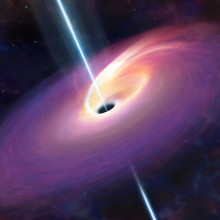
00:31 - Spotting A Black Hole Swallowing a Star
Spotting A Black Hole Swallowing a Star
A unique astronomical event - an incredibly bright and long lived burst of gamma rays - was probably the result of a black hole destroying a star, according to research published in the journal Science this week.
On the 28th of March this year, NASA's swift satellite observed a bright flash of gamma rays emanating from a distant galaxy, around 3.8 billion light years away. Gamma Ray Bursts like this are associated with some of the most energetic and destructive events in our universe, such as the supernova and collapse of a massive star into a black hole or neutron star.
 This flash, now known by the catchy name of SW 1644+57, was unusual. Normal gamma rays bursts are intense, but short lived, and followed by an "after-glow" of lower intensity emission. The event in March continued for weeks, outlasting any previous burst, and rather than fading away quietly, it was followed by a number of less intense bursts of radiation - almost like an earthquake and its aftershocks.
This flash, now known by the catchy name of SW 1644+57, was unusual. Normal gamma rays bursts are intense, but short lived, and followed by an "after-glow" of lower intensity emission. The event in March continued for weeks, outlasting any previous burst, and rather than fading away quietly, it was followed by a number of less intense bursts of radiation - almost like an earthquake and its aftershocks.
To determine exactly what caused this unique event, it was vital to determine whereabouts in the galaxy it had occurred. Andrew Levan and colleagues at Warwick University used subsequent observations taken by the Hubble Space Telescope and Chandra x-ray observatory to confirm that the event had taken place at the heart of the galaxy.
This left only one logical conclusion as to the cause of the event - they had witnessed a star about the size of our Sun being torn apart by a massive black hole. The enormous gravitational pull of a black hole at least a million times the mass of the Sun would cause the star to initially distort into a banana shape, before being ripped into a ring of material, raining down onto the black hole.
Spinning black holes tend to radiate this energy in two highly columnated beams, one from each pole, and this time, the Earth happened to fall right in the firing line. Dr Levan now hopes to look at historical data to find evidence of off-axis events, where the column of light is not aimed at the Earth, to find out how rare these extraordinary events really are.
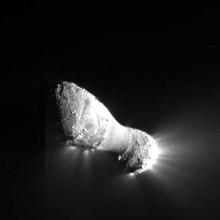
03:30 - Comet Hartley 2
Comet Hartley 2
Comets are small astronomical bodies that mostly travel from the far reaches of the solar system inwards. As they move closer to the sun they heat up, evaporating volatiles like carbon-dioxide and water to produce their characteristic tail.
They are quite difficult to study as although their tails can be enormous, the actual comet is relatively small. They are only a few kilometers across and surrounded by a cloud of tail forming particles when they are close to us. There have been a couple of missions to comets. The most recent was the NASA deep impact mission which was a bonus. After visiting the comet Tempel 1 in 2005 they visited the relatively small and unpredictable comet Hartley 2 in 2010. This comet is slightly unusual and spins peculiarly, occasionally showing hiccups in its tail. A team from the University of Maryland have just finished analysing the data from this flyby.
They have found that the comet looks like a giant 1km long dumbbell with jets of material flying out of the ends. At the moment slightly more material is flying out from the small end than the large one. The amount of water compared to carbon dioxide also appears to be lower at the small end than the large one. This might indicate that a comet has a varied structure in its original makeup.They also saw a very pristine white ring around the middle of the comet which indicates that some of the material flying out might be re-depositing around the middle.
So comets might be a more active and varied type of object than was previously thought. Hartley 2 will certainly continue to be studied from ground based telescopes to see if more can be learnt about its strange behaviour.
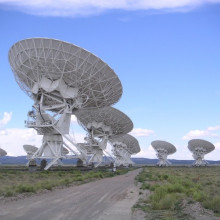
06:19 - South Africa and the Square Kilometre Array
South Africa and the Square Kilometre Array
Bernie Fanaroff, Project Manager of the SKA in South Africa
Ben - The Square Kilometre Array, or the SKA, is set to be a groundbreaking new radio telescope operating at a wide range of frequencies, with as much as 50 times more sensitivity than any existing telescope of its kind. It should help us to answer some of the really big outstanding questions about our universe. Now the headquarters will be based at the Jodrell Bank Observatory in Cheshire but the telescope itself is either going to be located in Australia or in South Africa. This week, Bernie Fanaroff, the project manager for the South African SKA bid, visited London and met up with our own Chris Smith.
 Bernie - It will be made up of two different kinds of what are called receptors. Most people will know what a satellite dish looks like. A satellite dish is really a mirror. It focuses radio waves from space onto a radio receiver. There'll be another kind of receptor which is more like a fish eye lens. It sits on the ground. You don't stir it physically, you stir it electronically, but it sees almost all of the sky all the time. So the Square Kilometre Array will be made up of a couple of thousand dishes and a thousand or so of these fish eye lenses. The dishes will be spread out over about 3,000 kilometres. The fish eye lenses are over a couple of hundred kilometres. They'll all be joined together with optical fibre, so they all look at the same thing at the same time. You feed the signals from all of these dishes and fish eye lenses together into one central computer. You can then process the data to make a picture of whatever it was that they were looking at.
Bernie - It will be made up of two different kinds of what are called receptors. Most people will know what a satellite dish looks like. A satellite dish is really a mirror. It focuses radio waves from space onto a radio receiver. There'll be another kind of receptor which is more like a fish eye lens. It sits on the ground. You don't stir it physically, you stir it electronically, but it sees almost all of the sky all the time. So the Square Kilometre Array will be made up of a couple of thousand dishes and a thousand or so of these fish eye lenses. The dishes will be spread out over about 3,000 kilometres. The fish eye lenses are over a couple of hundred kilometres. They'll all be joined together with optical fibre, so they all look at the same thing at the same time. You feed the signals from all of these dishes and fish eye lenses together into one central computer. You can then process the data to make a picture of whatever it was that they were looking at.
Chris - That must be one mega computer.
Bernie - Well, the estimates are that you'd have to have a computer running at exoflop speeds. Exoflop speeds is of the order of a thousand times faster than the fastest super computers now. The data transport would be several hundred terabits per second, so you're looking at a couple of hundred times more data traffic than you have through the entire worldwide web at the present time. So it pushes a lot of technological boundaries.
Chris - So why South Africa?
Bernie - Well first of all, we have an exceptionally good site. It's very quiet, radio quiet, in a sense that there's very little interference. We've been able to work with our signal broadcasters and our mobile phone operators as well as others, to reduce even further any signals that there are. So it's a very quiet site. The physical characteristics are good. We have large flat areas, temperatures and winds are benign. There's no extreme weather and there's a lot of infrastructure already in place so it's easy to put it down there. It also reduces the costs because the cost of construction is low. You've got some infrastructure but also, building in South Africa is just more affordable than it would be in many other places.
Chris - Is South Africa ready for this kind of project though? Because to develop that kind of computer and that kind of infrastructure, can the country deliver that at the moment?
Bernie - Well, we certainly can. First of all, we've got quite a good base of high tech industry as well as construction engineering industry with an international track record. We've done two things which have helped us to develop a really vibrant and world class community. The first one is that we've been building what we called a MeerKAT telescope which is a scaled down version of the Square Kilometre Array. It will have 64 dishes instead of a couple of thousand of them and will be on the same site in the Karoo. We've built the first 7 dishes and we're commissioning that as a prototype. Then, going with that, we've developed a big bursary and grants program to strengthen our universities. We have 5 research chairs in our universities. We've had 117 PhD and MSc students in engineering and astronomy. We've got about 100 undergraduates in physics and engineering and we're training new technicians and artisans. One of the things which has become clear is that the 100 or so young engineers and scientists who directly work on the project now, I'm excluding the ones in the university, are amongst the best engineers and scientists in the world. That has been recognised by the rest of the SKA International consortium.
Chris - And if it does go South Africa's way, what will this mean to the country if you get this?
Bernie - I think it'll be very important for us. First of all, it'll change the way we see ourselves. We'll see that we can be a centre for science and astronomy and one of the government's objectives from 1996 is for Southern Africa to be a centre of astronomy. The other thing is that I think it'll change the way the world sees us. We're already seeing a lot of very good academics and researchers wanting to come to South Africa to work on the MeerKAT and that wasn't easy a few years back. If we have the SKA in Africa we'll have more of those people coming in. That will strengthen our innovation system, our universities, and it will just strengthen the whole capability in these hi-tech and scientific areas.
Chris - And what are the really big questions that you're going to answer with this?
Bernie - The first one I think is that people would like to understand dark energy better. Why is the universe expanding faster and faster? What is the large scale structure of the universe? It has voids in it, bubbles, how do the bubbles originate? What has happened to the structure of the universe over the life of the universe? It will enable us to study galaxies and how galaxies form and evolve so that we can understand better what dark matter is. Both dark energy and dark matter are known to be there because we can see their effects, but we don't know what they are. So that is a very interesting challenge. It will also test Einstein's theory of gravitation by enabling us to look for gravitational waves and by enabling us to study what happens really close to black holes. It'll look for protoplanets. These are all very exciting questions.
Ben - Bernie Fanaroff talking to Chris Smith at the South African High Commission this week. Regardless which country, the SKA is planned to start construction in 2016 and should be fully operational by 2024. It'll be very exciting to see if that happens, and if it does, the results that they start getting.
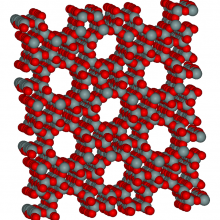
12:53 - Porous Molecules By Design
Porous Molecules By Design
Porous molecules, useful in a huge range of applications including separating chemicals and catalysing reactions, may be designed on demand thanks to a new method published in the journal Nature this week.
Molecules with well defined porosity and well understood activity, such as zeolites and metal-organic frameworks (MOFs), play important roles in many chemical processes. Touted as a safe solution to hydrogen storage due to their ability to adsorb enormous amounts of gas on their surfaces, they're also useful in water purification and as molecular traps. But their production often distributes functionality fairly randomly between the pores, placing an upper limit on their use.
 Professor Andrew Cooper, at the University of Liverpool, working with groups at University College London and Cambridge University, have developed a method for modelling nanoporous molecular frameworks with atomic precision, then producing them from modular components.
Professor Andrew Cooper, at the University of Liverpool, working with groups at University College London and Cambridge University, have developed a method for modelling nanoporous molecular frameworks with atomic precision, then producing them from modular components.
Cooper and colleagues use a "lock and key" assembly technique, mixing porous organic cage molecules and allowing them to self assemble. They can accurately model and predict how these molecular modules will mix, meaning specific functionality can be computer designed.
One of the advantages of this technique is that the molecules are soluble. This means that once the constituent pore modules are synthesised, researchers need only mix the modules in solution, allow them to self assemble, and then remove the solvent.
The researchers have put their method to the test, and produced four bespoke molecular cages, and confirmed their structure experimentally. This, they say:
"Opens the way for in silico prediction of structure and properties for new candidate porous materials based solely on two-dimensional chemical sketches, thus allowing 'design by computational selection'."
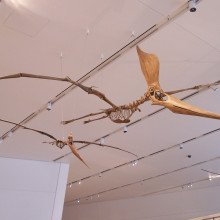
15:40 - Pterosaurs inspired aircraft
Pterosaurs inspired aircraft
Although for most airliners being able to change direction very quickly isn't hugely important, as unmanned aerial vehicles are getting used more and more, especially in complex urban environments, being able to turn sharply can make the difference between carrying on its mission or ending up splattered against a wall.
A very productive seam of ideas for engineers has been bio-mimetics, copying ideas from living things. This has given us ideas ranging from velcro to catseyes in the road, but Brian Roberts and Rick Lind from the University of Florida and colleagues have been taking this strategy one step further. They have been taking ideas from dead creatures, very dead creatures that haven't lived for 65 million years, pterosaurs to be precise.
These were a form of flying reptile which survived for over 150 million years and included the largest ever flying animal with a wing span of 40 feet. One striking feature of many of these pterosaurs is that they have large head crests. It has been suggested that these were just for display but they may have had an aerodynamic purpose, acting like a rudder.
So the group wondered if putting your rudder at the front of a plane might be useful. They have done lots of modeling and found that for the same size rudder at the front of the plane, it should give the plane a 15% smaller turning circle. The problem is that you also loose stability so they are looking into somehow morphing or moving the rudder around to get the best of both worlds.
So in the future we might see pterosaur inspired planes flying around our cities. Who knows what else ancient animals and plants might inspire.





Comments
Add a comment